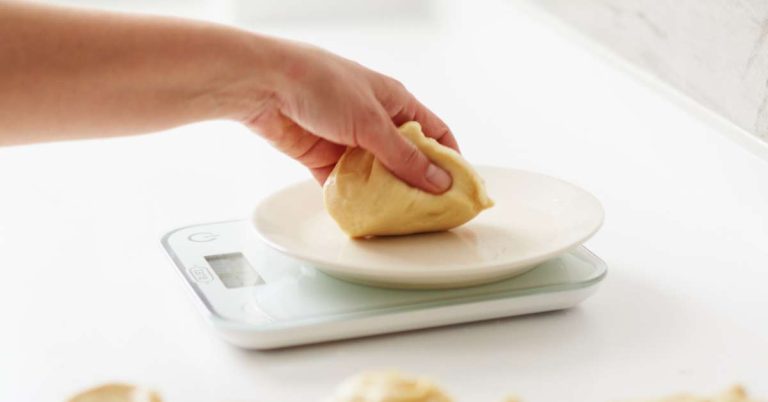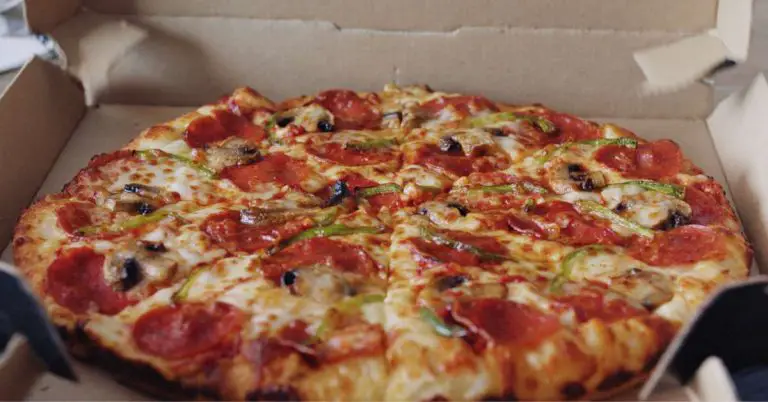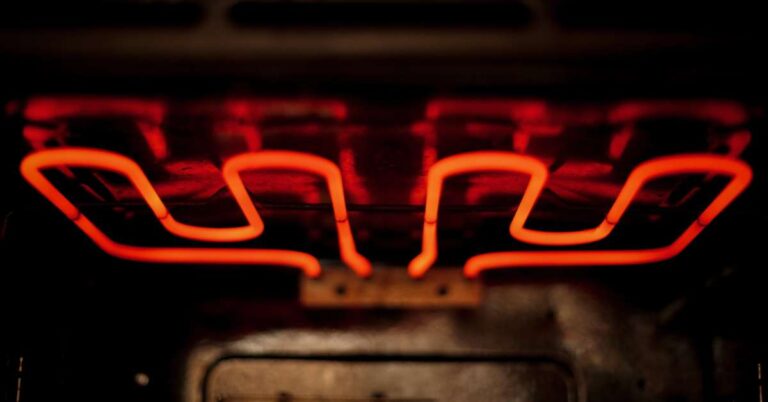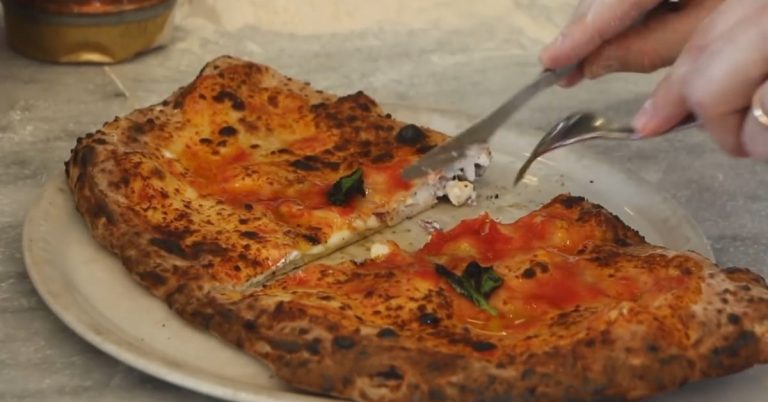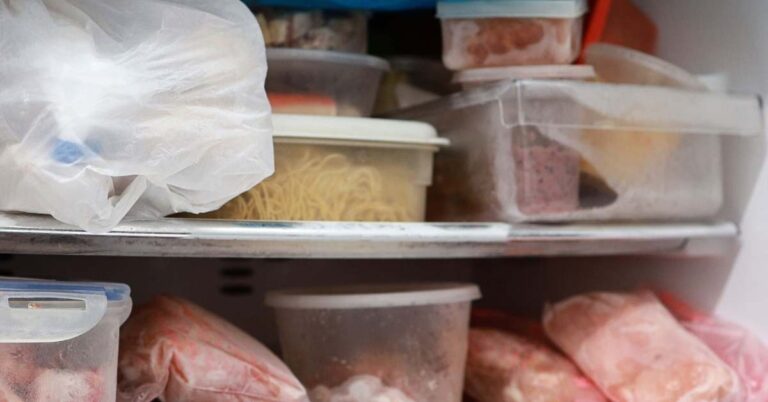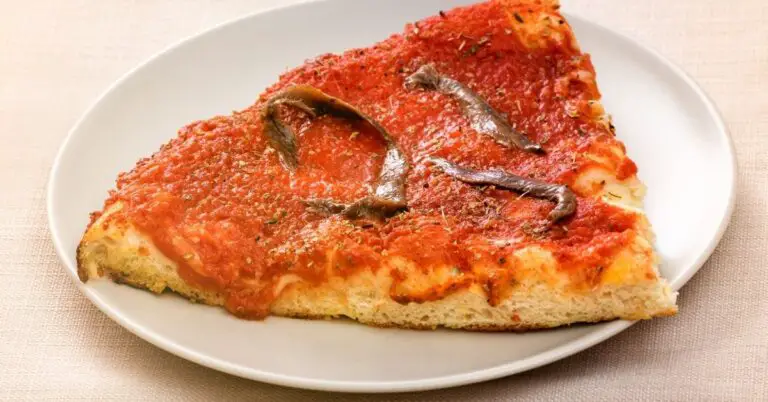How Many Calories are REALLY in a Slice of Pizza? More Than You Think…
I’m a Neapolitan pizza kind of guy, which means I don’t normally pay too much attention to the nutritional content of my pizza due to the generally nutritious and clean ingredients of that style. But if I’m eating pizza from a chain like Domino’s or Pizza Hut (or even just a local pizzeria) it’s a whole different story.
While pizza in general isn’t inherently unhealthy, major chain and frozen pizza can be downright bad for you. The average slice of pizza from a chain pizzeria has between 250-350 calories per slice (or an average of 205 calories per slice of frozen pizza) compared to only about 100-150 calories per each slice of Neapolitan style pizza. Of course, much of this depends on which Pizza Hut or Domino’s pizza crust types you choose.
- Pizza Hut Hand Tossed Large Cheese Pizza: 300 calories per slice
- Domino’s Hand Tossed Large Cheese Pizza: 270 calories per slice
- Pizza Hut Thin ‘N Crispy Large Pepperoni Pizza: 280 calories per slice
- Red Barron Frozen Cheese Pizza: 190 calories per slice
- DiGiorno Frozen 4 Cheese Pizza: 232 calories per slice
Chain and frozen pizza is so high in calories mainly due to excess toppings, out of control portion sizes, and an over-reliance on highly-processed ingredients. This increases the overall fat and calorie content of the pizza, as well as adding (sometimes) dangerously high levels of sodium. As you’ll learn, making healthy topping and crust choices when ordering pizza delivery can be a great way to reduce calories per slice, as well as increase the amount of nutrients in your diet.
What’s Ahead: In this post, I’m going to be looking specifically at how many calories are in a slice of pizza based on a number of variables including brand, pizza size, toppings, and crust type. This information is especially useful for those interested in losing weight or maintaining a healthy diet. I’ll also provide some additional nutritional information like protein, sodium, and carbohydrates for reference.
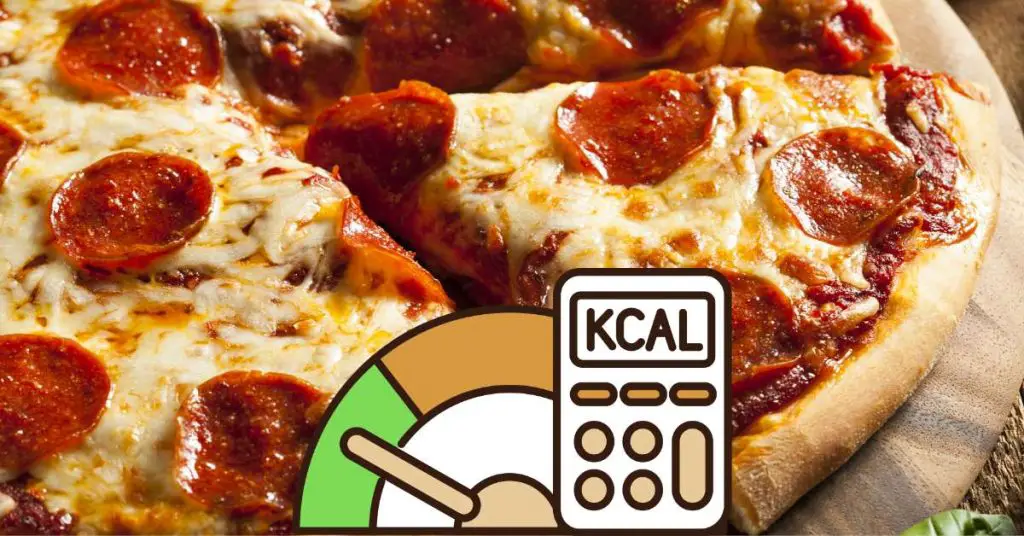
Pizza Nutritional Facts
Pizza has become a staple comfort food for many people around the world, but it’s important to understand its nutritional value (or lack thereof) in order to make the best choices for your diet and lifestyle.
While pizza can be high in calories and fat, it also offers some important nutrients. So, before we get into a nutritional breakdown of a slice of pizza by brand and toppings, let’s first look at what nutrients are commonly found in pizza.
Calories

An average slice of pizza from one of the major chain pizzerias has around 250-350 calories, but this will vary by size, crust type, toppings, as well as which particular chain it comes from.
Chain pizza is often high in calories because of an over-reliance on highly-processed ingredients, such as artificial additives, extra sodium, and added fat. In addition, chain pizzeria brands tend to use use large amounts of cheese and are heavy-handed with toppings, all of which add to the calorie dense nature of their product.
To make matters worse, chain portion sizes tend to be much larger than with traditional pizza styles, with extra sugar added to the dough, sauce, and other toppings. Sugar can improve the taste of the pizza for some people (as well as make it slightly addictive), but in the end all that extra sugar just adds more calories.
Carbohydrates
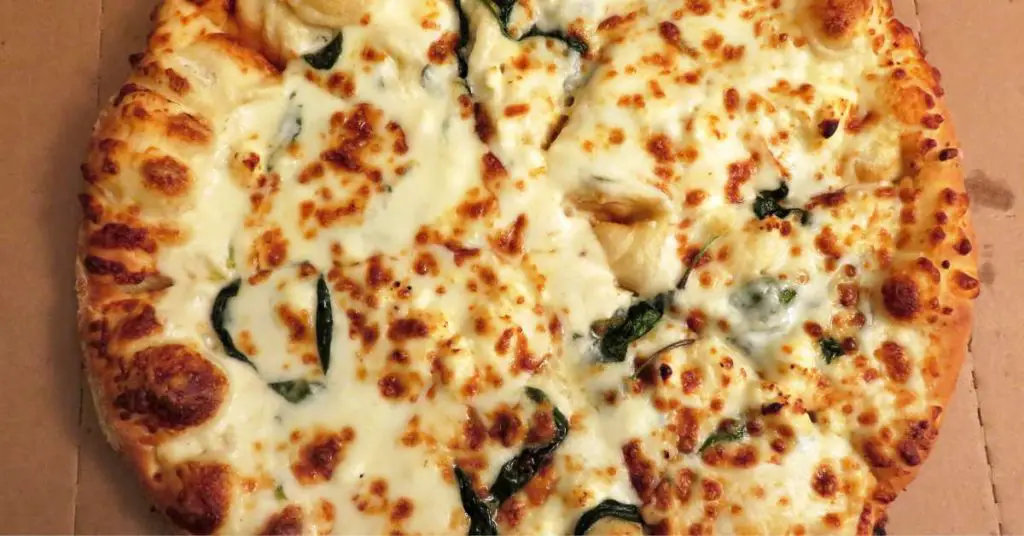
Chain pizza is typically high in carbohydrates due to its relatively thick crust and lots of additional toppings. In fact, the average slice of pizza from one of the major chains has as many as 20-30 carbs per slice, and that’s assuming you’ve only added 1 or 2 toppings. The thicker the crust, and the more unhealthy, highly-processed toppings you include, the higher the overall carbohydrate count will be.
Even Chain Pizza Has Some Nutritional Value
While chain pizza is generally unhealthy, it still contains some nutrients such as protein, calcium, vitamins, and minerals that are essential to a balanced diet and a healthy lifestyle.
Protein
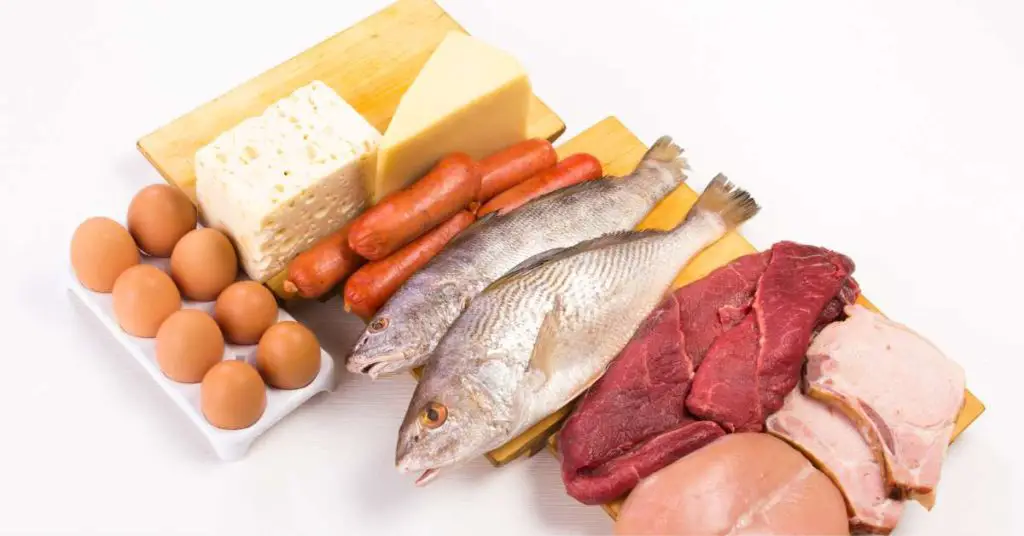
Protein is important for building muscle and maintaining overall health, and chain pizza is typically high in protein due to the large amounts of toppings used such as meat and cheese. On average, a slice of chain pizza contains around 10-15 grams of protein per slice. However, the protein content can vary depending on the type of crust and toppings.
It’s also important to note that while chain pizza can be high in protein, the ratio of protein to calories is generally low due to the large portion sizes and thick crust.
So, while the amount of protein in a slice of chain pizza is usually higher than in a slice of fresh Neapolitan pizza, you’re actually getting far more nutrients per serving when you opt for Neapolitan pizza instead due to its much smaller portion size.
Calcium
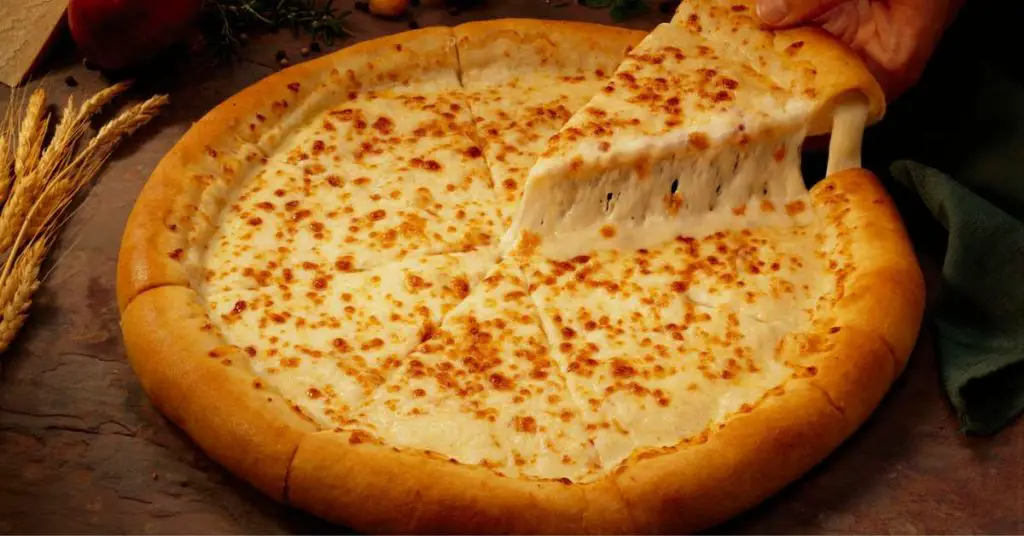
Most pizza contains some form of cheese as a primary topping, which happens to be one of the best sources of dietary calcium. In fact, even chain pizza can contain as much as 150mg of calcium in a single large slice. Adequate calcium intake is essential for maintaining healthy bones and teeth. (source)
Vitamins
Chain pizza also contains small amounts of essential vitamins as well, particularly vitamin C and vitamin A. This is especially true if you opt for fresh vegetable toppings like bell peppers, spinach, and jalapenos (for example). These vitamins are necessary for maintaining healthy skin, blood pressure, and general immunity functions. (source)
Of course, it’s important to note that which nutrients are present and their quantities will vary significantly depending on which toppings you choose, how fresh they are, and which pizza chain you order from.
Minerals
Even iron and zinc can be found in chain pizza, which are both essential for producing red blood cells and strengthening the immune system. Depending on which toppings you choose, like mushrooms or olives for example, chain pizza can contain small levels of magnesium and potassium as well. (source)
But while chain pizza usually contains some important nutrients, fresher styles of pizza like Neapolitan will always contain more. This has to do with the amount of fresh high-quality ingredients used to make Neapolitan pizza, as well as the high temperature and shorter cooking time which preserves more of the nutrients in the finished product.
Calories Per Slice of Pizza by Brand
For those trying to lose weight (or maintain a healthy one), caloric content is one of the most important things to keep in mind when choosing which kind of pizza to eat. This section will examine how many calories are in each brand of pizza, and how that can vary depending on the size of the pizza and the type of crust used.
I’ll also be looking a few other nutritional values for reference as well, such as carbs, protein, and fat.
| Brand | Crust Type | Size | Slices | Calories per Slice | Carbs per Slice (g) | Fat per Slice (g) | Protein per Slice (g) |
|---|---|---|---|---|---|---|---|
| Pizza Hut | Hand Tossed | Large | 8 | 300 | 20 | 8 | 12 |
| Pizza Hut | Hand Tossed | Medium | 8 | 210 | 14 | 6 | 8 |
| Pizza Hut | Thin ‘N Crispy | Large | 8 | 260 | 18 | 7 | 10 |
| Pizza Hut | Thin ‘N Crispy | Medium | 8 | 180 | 12 | 5 | 6 |
| Pizza Hut | Original Pan | Large | 8 | 390 | 26 | 14 | 16 |
| Pizza Hut | Original Pan | Medium | 8 | 270 | 18 | 10 | 12 |
| Pizza Hut | Original Stuffed Crust | Large | 8 | 305 | 21 | 12 | 14 |
| Domino’s | Hand Tossed | Medium | 8 | 200 | 14 | 8 | 10 |
| Domino’s | Hand Tossed | Large | 8 | 270 | 19 | 11 | 14 |
| Domino’s | Handmade Pan | Medium | 8 | 250 | 18 | 11 | 12 |
| Domino’s | Handmade Pan | Large | 8 | 340 | 24 | 15 | 16 |
| Domino’s | Crunchy Thin | Medium | 8 | 170 | 12 | 5 | 9 |
| Domino’s | Crunchy Thin | Large | 8 | 230 | 16 | 7 | 12 |
| Domino’s | Brooklyn Style | Medium | 8 | 290 | 20 | 13 | |
| Domino’s | Brooklyn Style | Large | 8 | 380 | 26 | 12 | 12 |
The table above assumes you’re ordering a standard cheese pizza, while the following table shows how this caloric range changes if you choose pepperoni instead.
| Brand | Pizza Type | Crust Type | Total Slices | Calories per Slice |
|---|---|---|---|---|
| Domino’s | Pepperoni | Hand Tossed | 8 | 210 |
| Domino’s | Pepperoni | Handmade Pan | 8 | 330 |
| Domino’s | Pepperoni | Crunchy Thin Crust | 8 | 170 |
| Domino’s | Pepperoni | Brooklyn Style | 8 | 290 |
| Pizza Hut | Pepperoni | Hand Tossed | 8 | 310 |
| Pizza Hut | Pepperoni | Thin ‘N Crispy | 8 | 280 |
| Pizza Hut | Pepperoni | Original Pan | 8 | 400 |
| Pizza Hut | Pepperoni | Original Stuffed | 8 | 330 |
| Pizza Hut | Pepperoni | Gluten Free | 4 | 150 |
Pizza Hut
Pizza Hut offers several different types of crust for their pizza, including Hand Tossed, Thin ‘N Crispy, Original Pan, and Original Stuffed Crust. As always, the number of calories per slice will vary depending on the crust and size of the pizza.
Hand Tossed Crust:
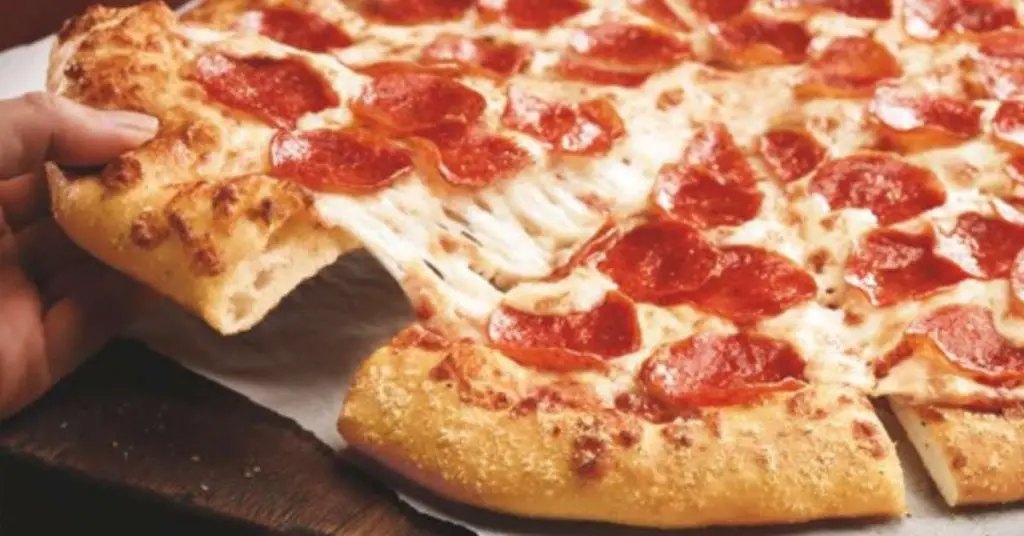
A large Hand Tossed crust cheese pizza from Pizza Hut has 8 slices, with each slice having 300 calories, 20 grams of carbs, 8 grams of fat, and 12 grams of protein. A medium Hand Tossed crust pizza has 8 slices, with each slice having 210 calories, 14 grams of carbs, 6 grams of fat, and 8 grams of protein.
Thin ‘N Crispy Crust
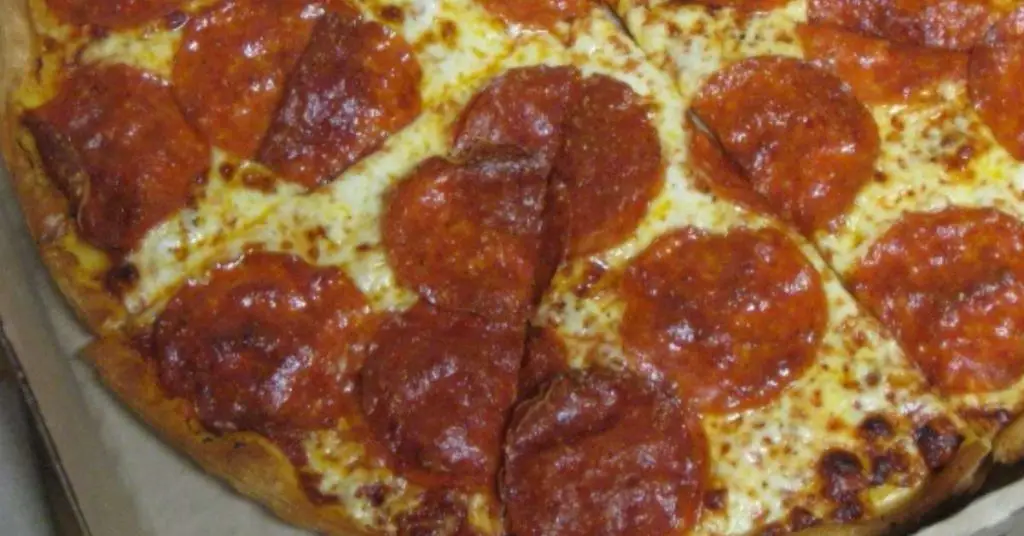
A large Thin ‘N Crispy crust cheese pizza from Pizza Hut has 8 slices, with each slice having 260 calories, 18 grams of carbs, 7 grams of fat, and 10 grams of protein. A medium Thin ‘N Crispy crust pizza has 8 slices, with each slice having 180 calories, 12 grams of carbs, 5 grams of fat, and 6 grams of protein.
Original Pan Crust
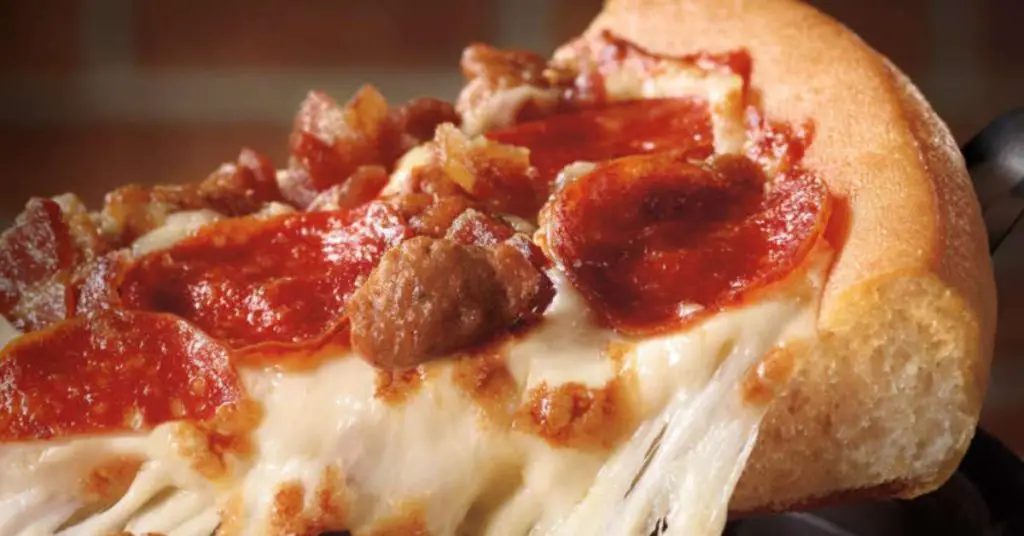
A large Original Pan crust cheese pizza from Pizza Hut has 8 slices, with each slice having 390 calories, 26 grams of carbs, 14 grams of fat, and 16 grams of protein. A medium Original Pan crust pizza has 8 slices, with each slice having 270 calories, 18 grams of carbs, 10 grams of fat, and 12 grams of protein.
Original Stuffed Crust
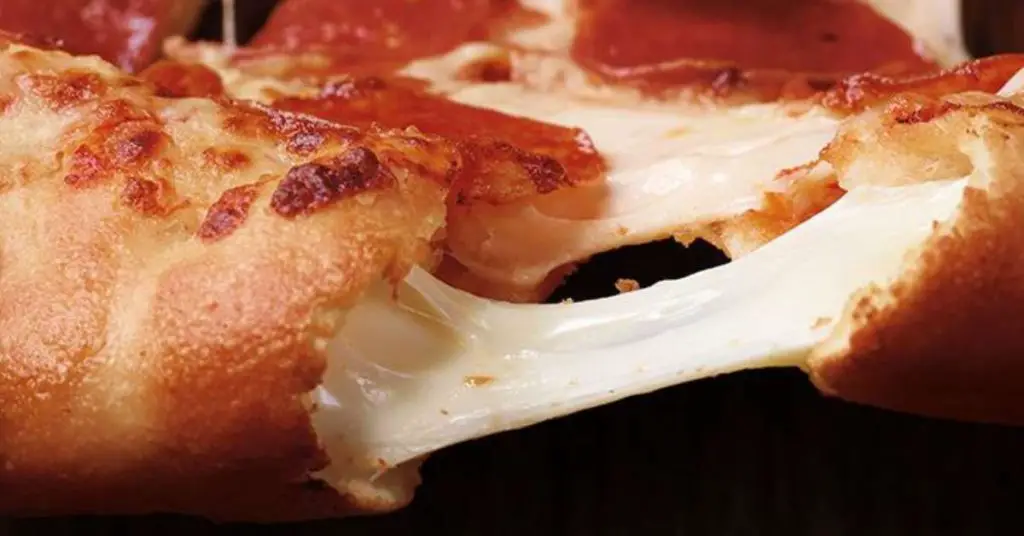
A large Original Stuffed Crust cheese pizza from Pizza Hut has 8 slices, with each slice having 305 calories, 21 grams of carbs, 12 grams of fat, and 14 grams of protein.
Domino’s
Domino’s also offers a variety of crusts for their pizzas, including Hand Tossed, Handmade Pan, Crunchy Thin Crust, and Brooklyn Style. The number of calories per slice will vary depending on the crust and size of the pizza.
Hand Tossed Crust
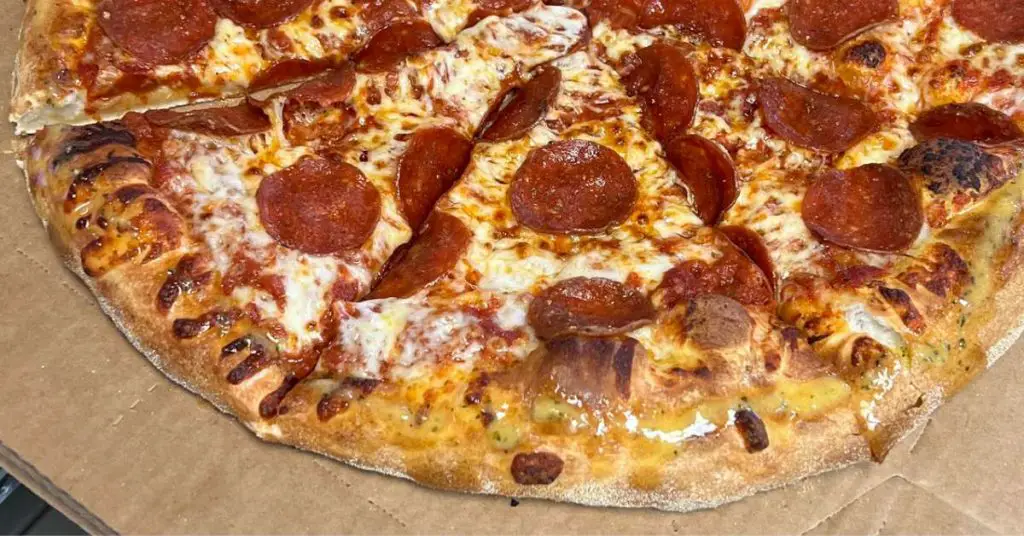
A medium Hand Tossed crust cheese pizza from Domino’s has 8 slices, with each slice having 200 calories, 14 grams of carbs, 8 grams of fat, and 10 grams of protein. A large Hand Tossed crust pizza has 8 slices, with each slice having 270 calories, 19 grams of carbs, 11 grams of fat, and 14 grams of protein.
Handmade Pan Crust
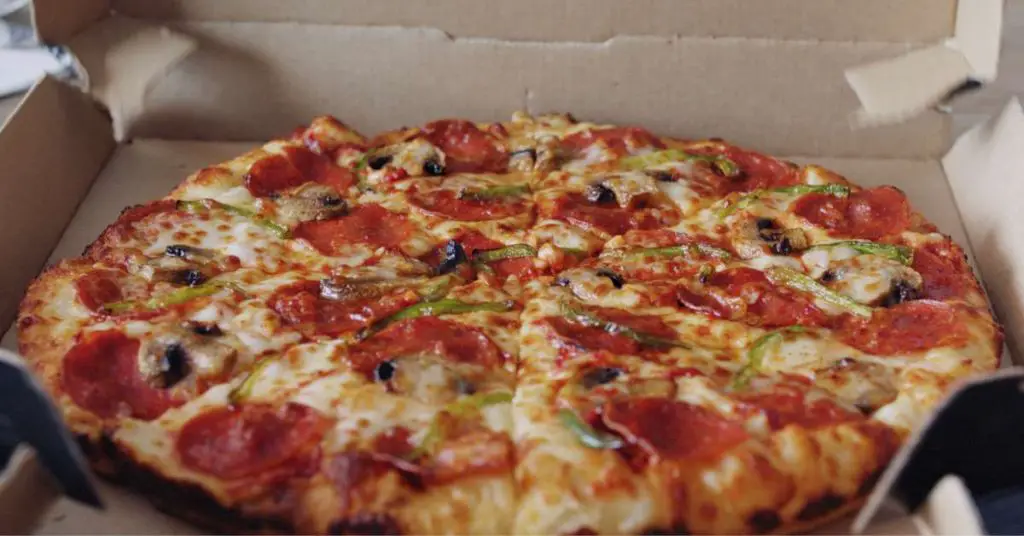
A medium Handmade Pan crust cheese pizza from Domino’s has 8 slices, with each slice having 250 calories, 18 grams of carbs, 11 grams of fat, and 12 grams of protein. A large Handmade Pan crust pizza has 8 slices, with each slice having 340 calories, 24 grams of carbs, 15 grams of fat, and 16 grams of protein.
Crunchy Thin Crust
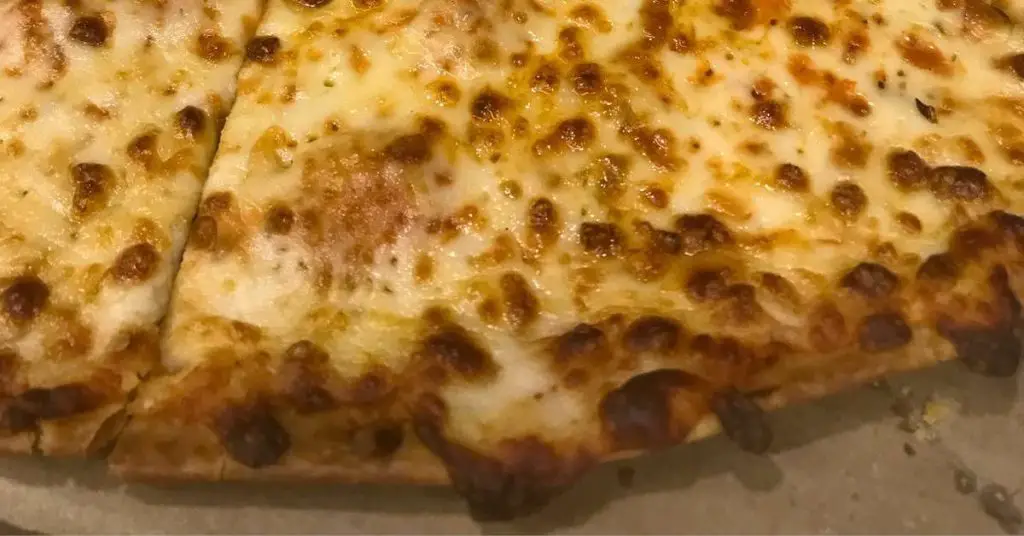
A crunchy thin crust cheese pizza from Domino’s has 8 slices, with each slice having 170 calories, 12 grams of carbs, 5 grams of fat, and 9 grams of protein. A large Crunchy Thin crust pizza has 8 slices, with each slice having 230 calories, 16 grams of carbs, 7 grams of fat, and 12 grams of protein.
Brooklyn Style Crust
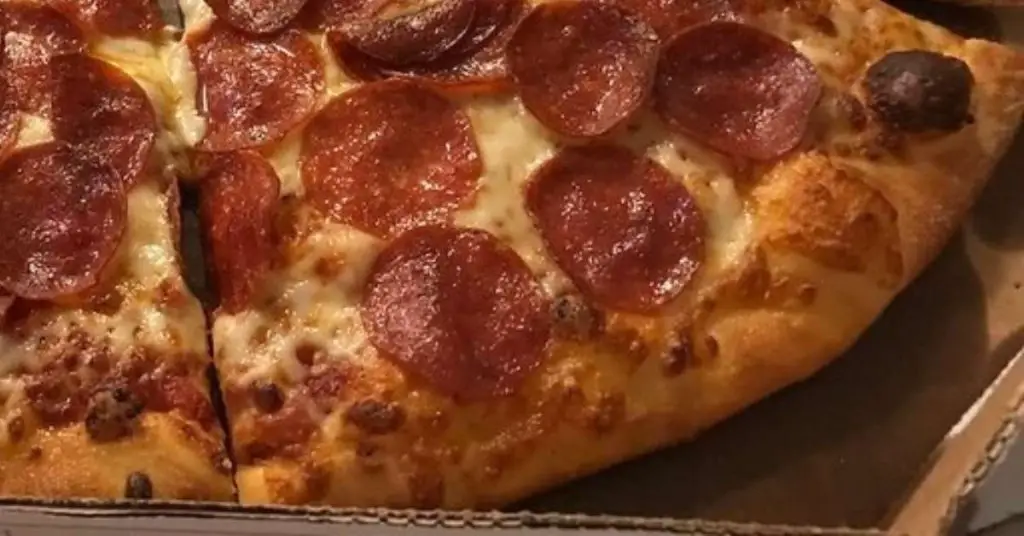
A medium Brooklyn Style crust cheese pizza from Domino’s has 8 slices, with each slice having 290 calories, 20 grams of carbs, and 13 grams of protein. A large Brooklyn Style crust pizza from Domino’s has 8 slices, with each slice having 380 calories, 26 grams of carbohydrates, 12 grams of fat and 12 grams of protein.
What about Frozen Pizza?
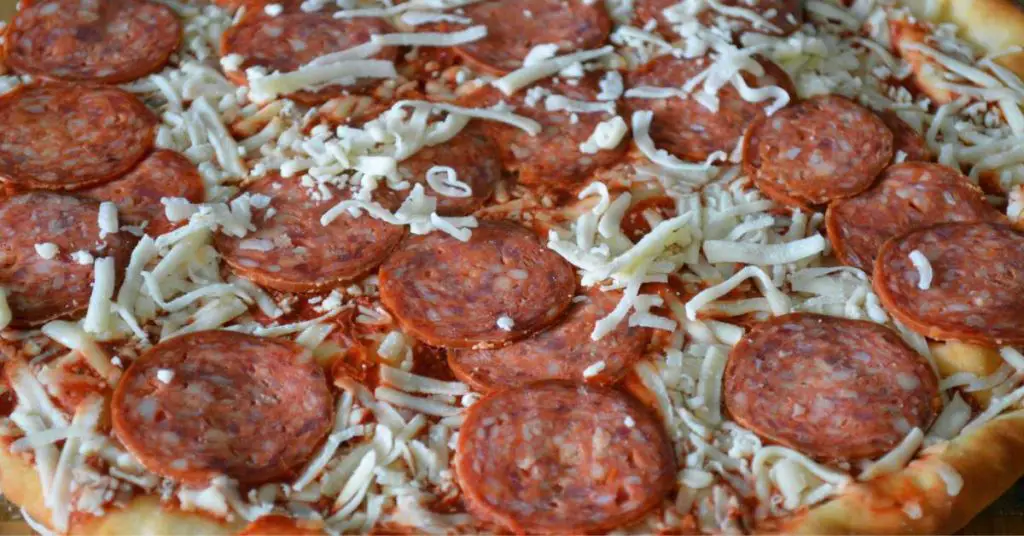
Just like the big chain pizzerias, frozen pizza is also known for its overuse of unhealthy, high-calorie, high-fat, highly-processed ingredients.
Of course, not all frozen pizza is unhealthy, but for the sake of comparison I’ll be focusing on the two biggest frozen pizza brands in the US—DiGiorno and Red Barron. These two brands are (in general) cheap and readily available for most North Americans at their local supermarkets, and even corner stores.
Like most cheap food, DiGiorno and Red Barron fall on the unhealthy side of the frozen pizza spectrum. How much, exactly? Let’s find out.
| Red Barron Pepperoni | Red Barron Cheese | DiGiorno 4 Cheese | DiGiorno Pepperoni Thin Crust | |
|---|---|---|---|---|
| Pizza Type | Pepperoni | Cheese | 4 Cheese | Pepperoni Thin Crust |
| Crust Type | Regular | Regular | Regular | Thin Crust |
| Size (inch) | 12 | 12 | 12 | 12 |
| Slices | 8 | 8 | 8 | 8 |
| Calories/slice | 186 | 190 | 232 | 213 |
| Carbs/slice (g) | 20 | 20 | 30 | 20.7 |
| Fat/slice (g) | 7 | 8 | 7.6 | 10 |
| Protein/slice (g) | 8 | 9 | 11.3 | 10.6 |
| Sodium/slice (mg) | 370 | 345 | 638 | 501 |
As you can see, the table above shows that the DiGiorno 4 Cheese pizza has the most calories (232) per slice, while the Red Baron Cheese has 190 calories per slice. This is mostly likely because of all the extra cheese added in lieu of other toppings.
When it comes to sodium, however, the pepperoni slices from each brand have the most with Red Barron pepperoni at 370g per slice and the DiGiorno pepperoni at 501g per slice. This isn’t surprising considering that processed meats like pepperoni are high in sodium—especially the cheap, low quality kind used by major frozen pizza brands.
Frozen Pizza vs Chain Pizza: Which is Least Healthy?
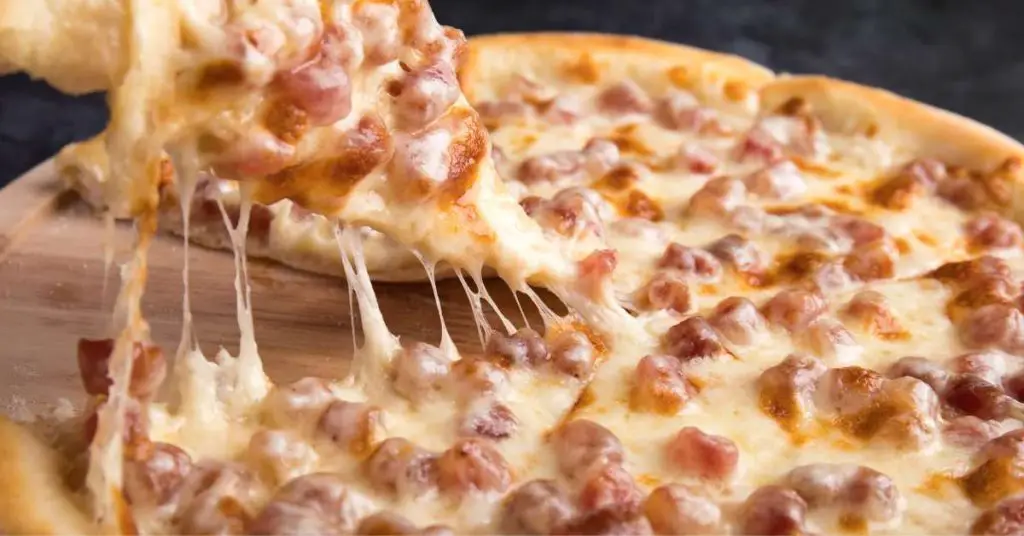
When it comes to choosing between a fresh pizza from one of the major chains or a frozen pizza from your freezer, it unfortunately is a choice between bad and worse. In fact, there’s actually very little difference between a chain pizza and frozen pizza from a health perspective—both are highly processed and contain way too much sodium, saturated fat, and calories.
To help you visualize these similarities, just look at the table below:
| Brand | Pizza Type | Crust Type | Size (inches) | Slices | Calories per Slice | Sodium per Slice (mg) | Protein per Slice (g) |
|---|---|---|---|---|---|---|---|
| Pizza Hut | Pepperoni | Regular | 14 | 8 | 300 | 600 | 12 |
| Domino’s | Pepperoni | Regular | 14 | 8 | 250 | 550 | 10 |
| Red Barron | Pepperoni | Regular | 12 | 8 | 185 | 480 | 8 |
| Red Barron | Cheese | Regular | 12 | 8 | 189 | 460 | 9 |
| DiGiorno | 4 Cheese | Regular | 12 | 8 | 232 | 638 | 11.3 |
| DiGiorno | Pepperoni | Thin | 12 | 8 | 212 | 501 | 10.6 |
While both frozen pizza and chain pizza have very high calorie and sodium levels per slice, frozen pizza actually has more per volume when you consider that chain pizza slices are generally bigger and heavier to begin with.
Takeaway: If money is not a concern, I recommend going with a chain pizza over a frozen one. Both are unhealthy, but with chain pizza, at least you’re getting something that resembles a real pizza crust compared to the fake cracker-like crust of a frozen pizza. It’s also nice to have something fresh vs something that’s been frozen for (perhaps) years before you eat it.
Neapolitan Style Pizza – The Healthiest Choice
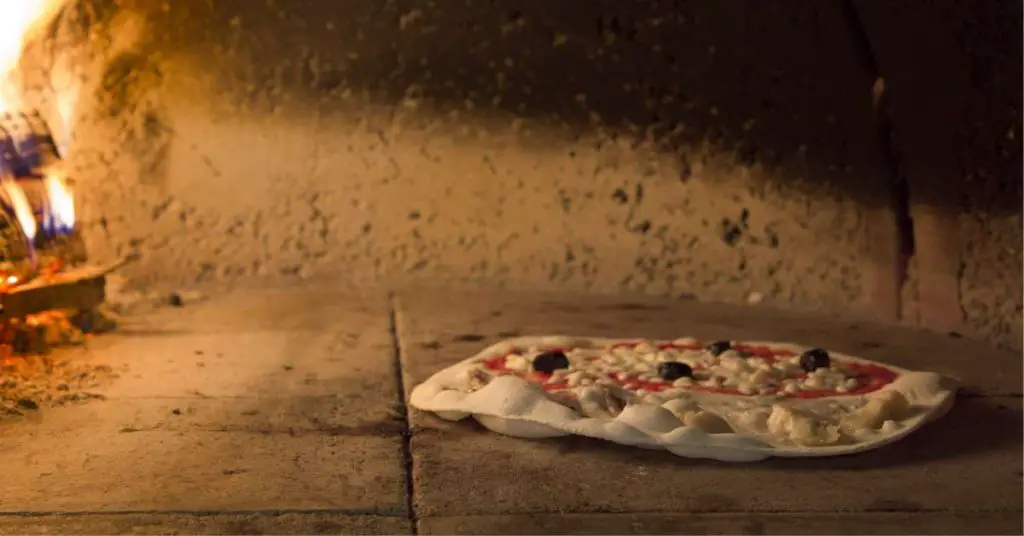
Not all pizza styles are created equal. While most of the major chains offer a variety of crusts and toppings, none of the ones I’m aware of offer a traditional Neapolitan style pizza. It’s a shame, too, because this style of pizza is made with a thin, crispy crust, fresh tomatoes, fresh mozzarella cheese, and fresh basil—all of which are packed with nutrients and come with almost no negative health effects.
This is why Neapolitan style pizza is my preferred “healthy pizza choice”, and the first style I’ll recommend to anyone thinking of cutting back on their pizza consumption for health reasons. It’s hardly a compromise either, because (in my opinion) Neapolitan pizza is the tastiest and leaves me feeling most satisfied and with no ill-effects afterwards.
- Related Post: My Neapolitan Pizza Recipe
Why Neapolitan Pizza is Healthier
The nutrition facts of the Neapolitan pizza are quite different compared to other styles of pizza. Pizza Margherita, for example, has an energy value of about 800 calories (made from a 250g ball of dough).
Pizza Marinara, on the other hand, has an energy value of about 550 calories (250g dough). This is because Neapolitan style pizza is made with only a few simple, fresh ingredients, and it is cooked quickly at a high temperature.

One of the main benefits of Neapolitan style pizza is that it’s lower in calories and fat compared to other styles of pizza. It also contains more vitamins and minerals, as well as less preservatives and additives. Additionally, Neapolitan pizza is made with high-quality ingredients, such as fresh mozzarella cheese and organic tomatoes.
Another benefit of this style pizza is that it is more easily digestible. Aside from its generally cleaner and simpler ingredients, Neapolitan pizza dough is fermented for at least 24 hours before baking. During the fermentation process, the live yeast culture in the dough breaks down gluten and starch which makes it easier for the body digest. Fermented pizza dough also tastes better and has probiotic effect, which can improve overall gut health.
Other Ways to Make Chain Pizza Healthier
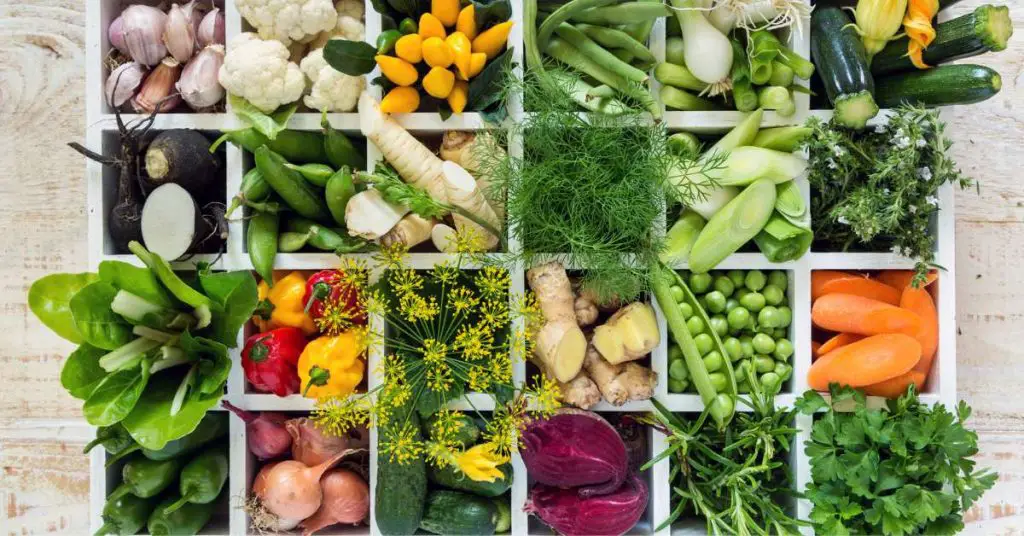
I’ve made it clear by now that Neapolitan pizza is my preferred healthy pizza choice, but I appreciate that for many of you chain (or frozen) pizza is the only option available.
Luckily, there are still some steps you can take to ensure that your chain pizza choices are as “healthy” as possible—or at least not as unhealthy as they could be. Most of these choices involve opting for the most nutritious toppings and minimizing the unhealthy ones.
One of the easiest options is to opt for a thinner crust, as it generally contains fewer calories and carbs. Another option is to go for a smaller size, or to share with friends or family. Additionally, you can choose to add more vegetables as toppings, and to opt for lean protein options like chicken or seafood instead of high-fat meats like pepperoni or sausage.
Taking Domino’s as an example, a medium hand tossed crust pizza from Domino’s has 8 slices with each slice having 200 calories. On the other hand, a medium thin and crispy crust pizza also has 8 slices, but each slice only has 170 calories. This means by simply choosing a thin crust over a regular crust, you can reduce the total calories by as much as 15%.
Choices like this may not seem like a huge difference, but over time it will greatly reduce the total amount of unhealthy ingredients you’re consuming. Here is a list of more healthy options you can make next time you visit one of the big pizza chains:
- Order a thinner crust: Thinner crusts generally have fewer calories, carbs, and other unhealthy ingredients than thicker crusts.
- Go light on the cheese: Extra cheese can add a lot of calories, fat, and sodium to your pizza. This is especially true for the kinds of pre-shredded, low-moisture, heavily-salted processed cheeses that are common at chain pizzerias.
- Ask for more veggies: Adding vegetables like bell peppers, spinach, and jalapenos can boost the nutritional content of your pizza while also adding flavor. If you have the opportunity, opt for as many vegetables as possible.
- Choose lean protein meats: Opt for chicken, turkey, or lean ground beef instead of pepperoni or sausage. These have more nutrients and are less processed than the typical chain pizza meat based toppings.
- Cut down on sugary sauces: Many pizza sauces contain added sugar, which can boost the calorie count and glycemic levels. Ask for light or no sauce to cut down on calories.
- Try a whole wheat crust: Whole wheat crusts are higher in fiber and other nutrients than highly refined white flour based crusts. If your local chain pizzeria offers this kind of crust, give it a try.
- Skip the deep-dish: Deep-dish pizza is almost always higher in calories and fat than the typical thin-crust pizza.
- Smaller portions: Larger pizzas have more slices, which means more calories. If you’re eating a pizza by yourself, opt for a medium or a small size.
- Ask for extra herbs: Herbs like basil, oregano, and garlic can add flavor to your pizza without adding calories. This can be a much healthier choice than adding extra tomato sauce or dips.
- Avoid anything labeled “stuffed” or “loaded”: As their names would suggest, these kinds of pizza tend to be higher in calories and other unhealthy ingredients than normal crusts.
Related Posts:
- Is Pizza Healthy? The Surprising Health Benefits Of Pizza
- What is Pizza? A Comprehensive Guide to (possibly) the World’s Most Delicious Food
- What Is Neapolitan Pizza?
- Best Temperature To Cook Neapolitan Pizza In Any Oven
- Why Does Pizza Make Me Sick? Plus How You Can Prevent It
Nutritional Sources:
- Domino’s Pizza
- Pizza Hut
- DiGiorno’s Frozen Pizza
- Red Barron Frozen Pizza
- Domino’s Calorie Calculator
Related Questions:
How many calories per slice of pepperoni pizza?
While caloric values vary by pizza size, brand, and toppings, you can expect the average slice of pepperoni pizza to have between 200-300 calories per slice. In fact, pepperoni pizza often has slightly less calories than the average slice of cheese pizza because cheese has more calories than pepperoni. Of course, pepperoni pizza is usually higher in sodium and protein compared to cheese pizza which offsets any perceived health benefits between the two pizza types.
How many calories per slice of cheese pizza?
The average slice of cheese pizza contains around 250-300 calories per slice, but this will vary quite a bit depending on the size and weight of each pizza slice, as well as the amounts of cheese and sauce used.
How many calories in the average slice of pizza?
Pizza comes in an almost limitless combination of toppings, shapes, and sizes, all of which affect the total caloric content per slice. Pizza with thick crust and lots of cheese will typically have more calories than a thin crust pizza with lots of meat and vegetables. However, in general, you can expect the average slice of pizza with an an average crust and amount of toppings to have about 300 calories per slice.
How many calories are in a slice of Costco pizza?
Costco pizza is large and thick, with a sugary sauce and lots of cheese, so you can expect it to have a much higher than average calorie account. In fact, a large Costco cheese pizza has a whopping 700 calories per slice. So, while a slice of Costco pizza might be a good value for the money, it’s also supremely unhealthy and should only be eaten in moderation.
How many calories in 2 slices of pizza on average?
Considering that the average slice of pizza with 1-2 toppings has between 250-300 calories per slice, you can expect 2 slices of pizza to have around 500-600 calories total. Keep in mind that a thicker slice of pizza with lots of cheese will have more calories than a thin slice of pizza with less cheese.
How many calories in 3 slices of average pizza?
If an average slice of pizza has (typically) 250-300 calories, 3 slices of pizza will have somewhere between 800-900 total calories. For those looking to reduce how many calories they consume, consider opting for thin slices of pizza with less cheese and more lean meats and vegetables.
How many calories in an average slice of New York style pizza?
In general, New York style pizza is large but also has a very thin crust, meaning it will have as many or more calories compared to the average pizza slice elsewhere—about 300-400 calories. That said, in terms of calories per slice by weight, New York style pizza will often have less calories compared to a slice of Pizza Hut or Domino’s of a similar size and weight due to its much thinner crust and less cheese. Of course, this will vary depending on how much cheese and other toppings you include on each New York style slice, as well as by individual pizzerias.
How many calories in a slice of Margherita pizza?
A Neapolitan slice of pizza margherita is one of the healthiest pizza choices you can make with as few as 100-150 calories per slice. This is primarily due to Neapolitan style pizza having a very thin, fermented crust, with few toppings including only fresh ingredients. Neapolitan style pizza is also low in fat, sodium, and carbohydrates as well.
How many calories in a small slice of pizza?
All things being equal, the smaller the slice of pizza, the fewer calories it will have. For example, a small slice of Domino’s hand tossed pizza will have about 200 calories, while an even smaller slice of personal pan pizza from Pizza Hut will have only about 150 calories. This is why moderation is key when it comes to eating pizza, especially mass-produced chain pizzeria style or frozen.
How many calories in a large slice of pizza?
The total amount of calories in a slice of pizza depends on the size of the whole pizza and the thickness of the crust. A large slice of pizza with an average crust thickness will typically have between 400-500 calories per slice. If the large slice of pizza is thick crust with lots of cheese and other toppings, it can have as many as 600 calories per slice.
Does thin crust pizza have fewer calories than regular crust?
The single greatest source of calories in an average slice of pizza comes from the crust, so opting for thin crust vs a traditional crust is a great way to reduce the total calories per slice. For example, a large slice of hand tossed pizza from Domino’s has 270 calories per slice, while a large slice of Thin n Crispy Domino’s pizza only has 230 calories.
How many calories in a whole pizza on average?
Considering that the average slice of pizza has around 300 calories, and the average whole pizza contains 8 slices, you can expect the average large pizza to have a total of around 2400 calories. Keep in mind that this total will vary significantly depending on the type of crust you choose, how many toppings you include, and how much cheese is added.

